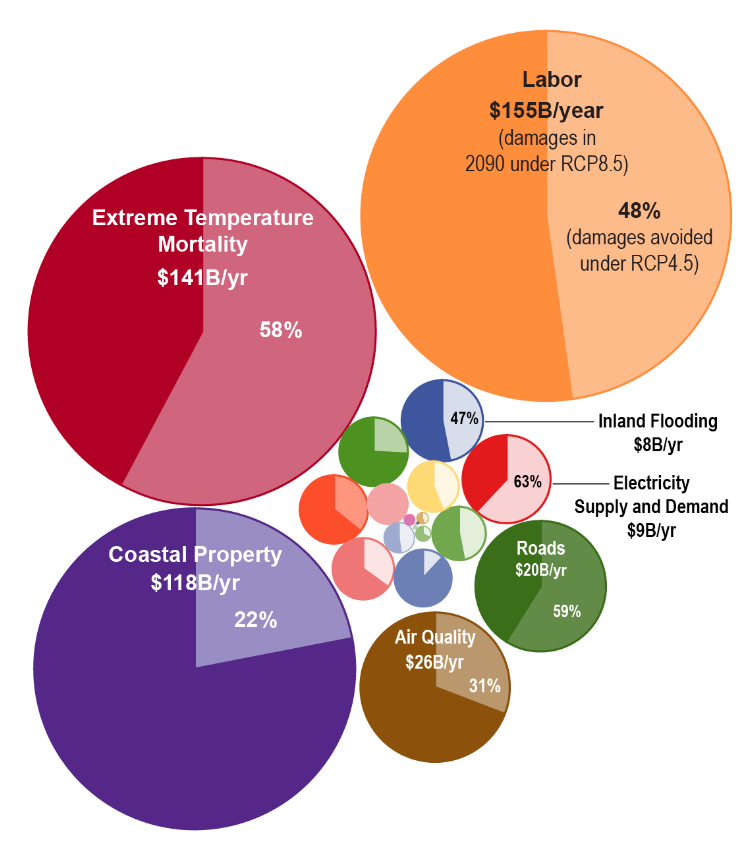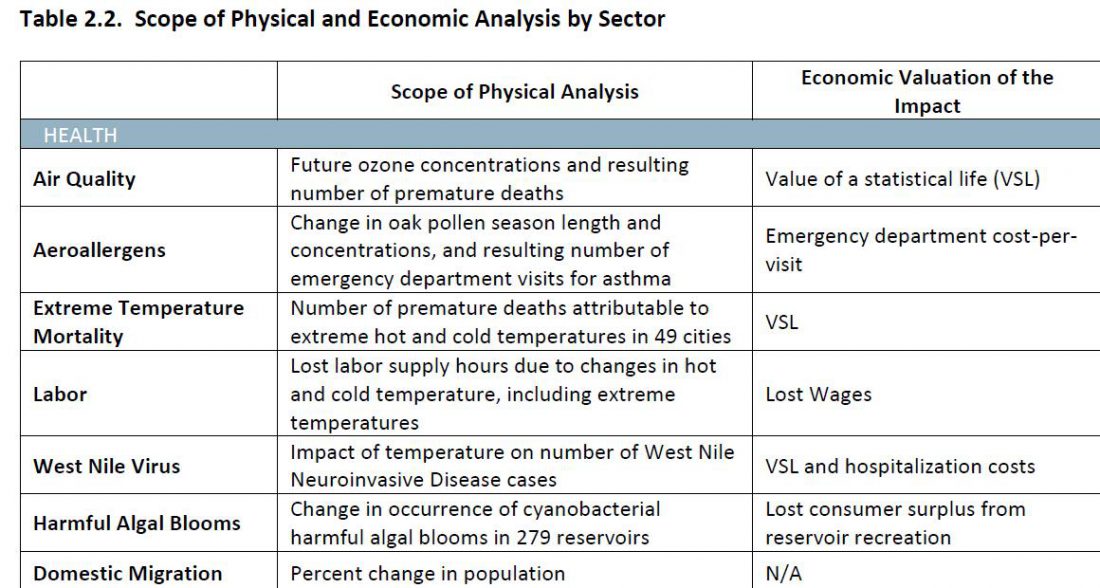In this blog I will continue to analyze the economic damage that the US government’s insistence on carrying on business as usual practices in the face of climate change will likely inflict on the country. Last week I discussed the recent NCA (National Climate Assessment) report and the damage it predicted.
I also incorporated some comments from the president and White House, including:
A White House statement said the report, started under the Obama administration, was “largely based on the most extreme scenario” of global warming and that the next assessment would provide an opportunity for greater balance.
Figure 1 from last week’s blog summarized the anticipated economic damages from a business as usual scenario. I am including it again here. Let’s look into the origins of the information it uses.

Figure 1 – Estimated annual economic damage by 2090 (NCA4 Ch29)
Figure 1 shows the economic consequences projected with the RCP8.5 scenario in 2090 and how much of that damage we could avoid by shifting to the RCP4.5 scenario. Chapter 29 of the report discusses this in more detail. The report cites its source for this information as the EPA’s May 2017 “Multi-Model Framework for Quantitative Sectoral Impacts Analysis: A Technical Report for the Fourth National Climate Assessment.” It was peer-reviewed with data available here. That analysis came out five months after the inauguration of President Trump and three months after the Senate confirmed his pick for EPA Administrator, Scott Pruitt – one of the leading climate change deniers in the country.
Last week I also compiled a partial list of steps that the president and his cohort have taken to disband many of the previous administrations’ earlier policies meant to mitigate the impacts of climate change. Most of these policy changes stemmed directly from Mr. Pruitt’s EPA. Today I have narrowed last week’s list to these specific policy reversals:
- October 2018 – EPA to disband air pollution review panel
- September 2018 – EPA repeals Obama-era methane rules
- August 2018 – Trump EPA unveils plan to nullify federal rules on coal power plants
- April 2018 – EPA starts rollback of car emissions standards
- February 2018 – EPA mulls shake-up to environmental research program
- January 2018 – EPA loosens regulations on toxic air pollution
- Report: climate change web sites ‘censored’ under Trump
- October 2017 – Trump EPA poised to scrap clean power plan
- May 2017 – EPA dismisses science advisors
- March 2017 – EPA scrubs climate change website
The EPA report’s goal and general structure are as follows:
This Technical Report summarizes and communicates the results of the second phase of quantitative sectoral impacts analysis under the Climate Change Impacts and Risk Analysis2 (CIRA) project (for information on the first phase, see the CIRA Project Background section). This effort is intended to inform the fourth National Climate Assessment3 (NCA4) of the U.S. Global Change Research Program (USGCRP). 4 The goal of this work is to estimate climate change impacts and economic damages to multiple U.S. sectors (e.g., human health, infrastructure, and water resources) under different scenarios. Though this report does not make policy recommendations, it is designed to inform strategies to enhance resiliency and protect human health, investments, and livelihoods.
Here is how the report suggests we interpret the results:
This Technical Report presents results from a large set of sectoral impact models that quantify and monetize climate change impacts in the U.S., with a primary focus on the contiguous U.S., under moderate and severe future climates. The CIRA analyses are intended to provide insights about the potential direction and magnitude of climate change impacts. However, none of the estimates presented in this report should be interpreted as definitive predictions of future impacts at a particular place or time. Instead, the intention is to produce preliminary estimates of future effects using the best available data and methods, which can then be revisited and updated over time as science and modeling capabilities continue to advance.
The CIRA analyses do not evaluate or assume specific mitigation or adaptation policies in the U.S. or in other world regions. Instead, they consider scenarios (Representative Concentration Pathways or RCPs6) to illustrate potential impacts and damages of alternative future climates. The results should not be interpreted as supporting any particular domestic or global mitigation policy or target. In addition, the costs of reducing greenhouse gas (GHG) emissions, and the health benefits associated with co-reductions in other air pollutants, are well-examined elsewhere in the literature and are beyond the scope of this report. For this reason, the analysis presented in this Technical Report does not constitute a cost-benefit assessment of climate policy.
Probably the most important paragraph in this section is the one that can serve as a direct rebuttal to the White House’s claim that the NCA report is the “worst case scenario.”
Furthermore, only a small portion of the impacts of climate change are estimated, and therefore this Technical Report captures just a fraction of the potential risks and damages that may be avoided or reduced when comparing the alternative scenarios. To better estimate impacts, this ongoing project continues to add new sectors, measures of economic damages, and adaptation scenarios, and to improve methods and assumptions within existing sectoral modeling. Impacts that are not covered by the modeling analyses and other important considerations or limitations are described in the discussion sections of each individual sector chapter.
The report’s Executive Summary covers the sectors of the analysis (the most important ones are shown in Figure 1), each with a specific example. For instance, this is regarding the cost to labor:
Under both atmospheric greenhouse gas (GHG) concentration scenarios modeled (Representative Concentration Pathways or RCP4.5 and RCP8.5), climate change is projected to significantly affect human health, the U.S. economy, and the environment. These climate change impacts will not be uniform across the U.S., with most sectors showing a complex pattern of regional-scale impacts.
For example, under RCP8.5, almost 1.9 billion labor hours across the national workforce are projected to be lost annually by 2090 due to the effects of extreme temperature on suitable working conditions, totaling over $160 billion in lost wages per year. More than a third of this national loss is projected to occur in the Southeast ($47 billion lost annually by 2090).
Figure 2 shows the projected temperature impacts of the two scenarios, based on the most sophisticated, internationally recognized computer modeling.

Figure 2 – Projected temperature rise across the US based on the two scenarios
Table 2.2 in the EPA report shows the economic indicators that are being used to monetize the health impact.

To demonstrate the consistency of the computer modeling, Table 5.1 shows the various estimates of changes in annual mortality by different computer models. It is, again, a great illustration that the report’s analysis is not based on the “worst case scenario” (i.e. it could be worse).


EPA 2017 Multi-Model Framework for Quantitative Sectoral Impacts Analysis, p. 55
Mr. Pruitt and President Trump had plenty of opportunities to change the report to reflect their own views on climate change. Fortunately, they decided not to do so. However, this decision leaves many of us with the strong suspicion that neither of them actually read these reports. In fact, the general opinions on climate change that they – and Andrew Wheeler (Acting EPA Administrator after Mr. Pruitt’s resignation) – express contradict the findings of the hardworking people they oversee. They are running roughshod over those trying to anchor political decision with facts. Most of us are confused by the results.

Denying climate change should be considered unethical in these times. Not wanting to acknowledge the impacts of what the rollbacks can and will impact many lives severely. This is an abuse of power where lives have been impacted.